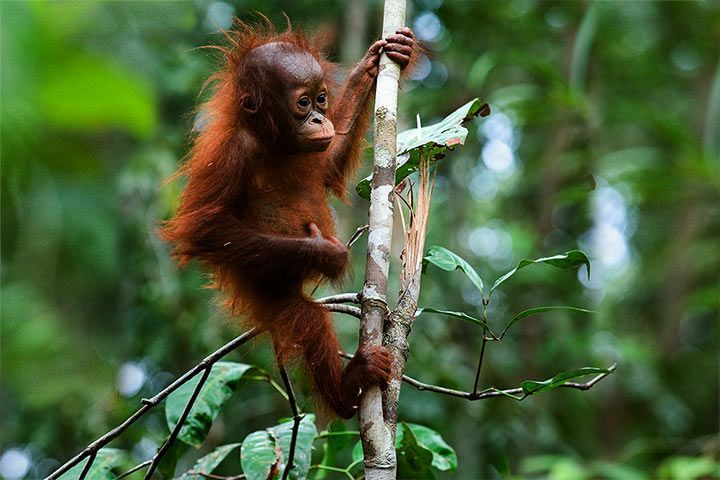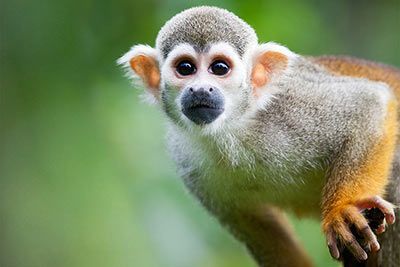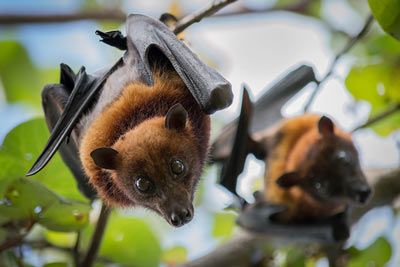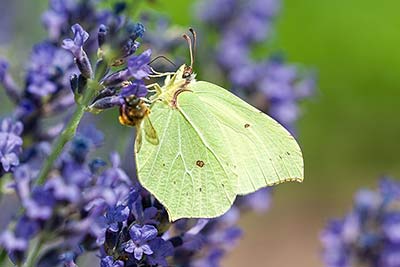Orangutan
Orangutan Facts
| Size | 47-59 inches (120-150 cm) |
| Speed | Up to 3.7 mph (6 km/h) |
| Weight | 66-200 pounds (30-90 kg) |
| Lifespan | 30-50 years |
| Food | Fruits, leaves, bark, insects, nuts |
| Predators | Tiger, clouded leopard, crocodiles |
| Habitat | Borneo, Sumatra |
| Order | Primates |
| Family | Hominids |
| Scientific name | Pongo |
| Characteristics | Great ape with orange, long fur; long arms |
Main Characteristics
Orangutans are large, intelligent great apes with orange fur and long arms. After gorillas, they are the second largest primates in the world. Two major differences set them apart from other great apes: they prefer to spend their time in trees and mostly live solitary lives.

Species
There are not just one, but three species: the Sumatran orangutan, Borneo orangutan and Tapanuli orangutan.
Distribution and Habitat
Orangutans live exclusively on two islands in Southeast Asia: Borneo and Sumatra. Their habitat is dense, tropical rainforests. They also like to stay near swamps and rivers.
Life Style
Orangutans are diurnal. Unlike other great apes, they spend most of the day high up in the trees. They climb and swing from branch to branch. This makes them the largest primates that live primarily in trees. What is also unusual for great apes: they are solitary creatures. Only the females and their offspring stay together.

Nature
Are Orangutans Aggressive?
Orangutans aren't aggressive. In fact, they rather try to avoid contact with people. They're considered to be the most peaceful great apes. They only show aggressive behavior towards their conspecifics during the mating season.
Are Orangutans Dangerous to Humans?
Orangutans are very peaceful and don't attack people unless they're cornered or feel threatened. However, there have been cases where people have climbed over fences in a zoo to take a close-up photo or video with orangutans. They were attacked, but escaped with a scare. In the wild, these animals prefer to stay away from us humans.

Anatomy and Appearance
Size and Weight
Orangutans are the largest primates in Asia. The male animals are significantly larger and heavier than the females. The males weigh 110-200 pounds (50-90 kg) and the females 66-110 pounds (30-50 kg).
Fur
Orangutans have reddish-brown to orange, shaggy fur.
Arms
When an orangutan spreads its arms, its wingspan can be over 6 feet (2 meters).
Cheek Pads and Throat Pouch
Male orangutans can develop cheek pads and a throat pouch. These characteristics grow larger over the course of their lives. However, they only develop in dominant males who have established their own territory. Females find the cheek pads to be quite appealing. The size of the throat pouch directly affects the length and volume of an orangutan's scream.

Diet
Orangutans mainly eat fruits such as mangoes, lychees, durians and figs. They make up 60% of their diet. They also feed on leaves, buds, young shoots and roots. Occasionally, they eat insects, bird eggs and small vertebrates, too.
Behavior
Communication
• Body Language
Orangutans mostly use body language to communicate with other animals. They point with their fingers, wave, or make other gestures with their hands. They even use small stones or branches to express themselves.
• Sounds
Orangutans also use sounds to communicate with their fellow species - especially the males. When they want to intimidate rivals or attract females, they emit long calls. The larger the throat pouch, the louder are the sounds.
Sleeping
Orangutans almost always stay in trees. They don't even climb down to the ground to sleep. They build a nest in a forked branch every day to spend the night in. It consists of a “mattress” as well as “pillows” and “blankets” woven from twigs and leaves.

Intelligence
Mirror Test and Tool Use
Orangutans are incredibly smart creatures. They're one of the few species that can recognize themselves in a mirror. They also use tools, which is a very rare ability among animals.
Umbrellas Made from Leaves
When it rains, they cleverly shield their heads with leaves to avoid getting wet. This makes perfect sense given their lengthy, shaggy fur. It simply takes too long for it to dry, especially since they don't have access to electric sockets and hairdryers in the jungle (just kidding).
Gloves and Napkins Made from Leaves
Orangutans are quite resourceful creatures. They not only make "umbrellas" out of leaves, but also craft "work gloves" to protect their hands from thorny bushes and fruits. Some even use leaves as napkins to clean food off their chins.
Fly Swatters Made from Small Branches
Mosquitoes are not only annoying to us humans, but also to orangutans. They try to get rid of them by building fly swatters out of small branches.
Insect and Fruit Skewers
Orangutans make use of twigs to fish tasty insects from their nests, crack open thorny fruits or steal some honey from a beehive.
Measuring Sticks Made from Branches
Orangutans stick long branches into bodies of water in order to find out how deep it is. This is essential for them to survive, because they can't swim. They only enter waters that are shallow enough for them to wade through. Orangutans even use branches to construct simple bridges so that they can pass swampy areas without getting their feet wet.
Own Medication
Orangutans don't need a doctor or pharmacist. They make their own medicines. When they're injured, they chew special leaves into a paste and smear it on their wound.
They Play Pranks on Others
In 2020, Scientists first observed orangutans playing tricks on each other. The animals clearly enjoyed the game and kept changing roles. It takes brains to assess conspecifics and plan “unforeseen” actions.

Senses and Abilities
Swinging From Branch to Branch
At times, the distance between two trees is a bit too much. To bridge the gap, an orangutan cleverly makes the tree it's perched on sway until it can reach out and grab hold of a branch from the neighboring tree. Just like Tarzan, it then swings over to the other side! It takes a lot of strength to do this.
How Strong Is an Orangutan?
Orangutans are exceptionally strong. They possess incredible strength especially in their arms and fingers. It is said that their grip strength is equivalent to a force of 440-660 pounds (200-300 kg). We humans manage up to 66-110 pounds (30-50 kg) at most.
Swimming
Orangutans can't swim. Their body is very heavy and they can't move their arms fast enough to stay afloat.
Language
• Human Language
Orangutans can't talk - at least they don't speak human language. They can mimic human sounds with some training. However, this is not the same as speaking. It's more like us humans trying to imitate a bird's voice by whistling.
• Orangutan Language
Orangutans communicate with their fellow species by using sounds. They even have a “vocabulary” which varies in size depending on the group and number of animals. They also use their vocal cords to create beatboxing sounds. Beatboxing is the practice of imitating drum rhythms with your voice.

Life Expectancy
Orangutans live to be 30-50 years old in the wild.
Enemies and Threats
Natural Enemies
The natural enemies of orangutans are tigers, clouded leopards and crocodiles.
Human Impact
• Poachers
Humans present a much larger danger to orangutans than their natural enemies. Poachers hunt them for their meat. Young orangutans are taken captive and sold as pets, often resulting in the death of their mothers.
• Destruction of the Habitat
The biggest threat they have to face is the destruction of their habitat. The forests that serve as their homes are being cleared for various purposes, such as logging or agriculture, including the cultivation of plants for palm oil production.
How Many Orangutans Are Left?
According to an IUCN estimate from 2017, there are 13,000 Sumatran orangutans left. In 2016, the WWF estimated that the maximum number of Borneo orangutans is 54,000. Sadly, the Tapanuli orangutan population is less than 800. All three orangutan species are “critically endangered.” Experts believe they could go extinct within a few decades.
Importance for the Ecosystem
Orangutans play a crucial role in maintaining the diversity of the tropical rainforest. They consume a variety of fruits and disperse their seeds, allowing new plants to thrive.
Reproduction
Orangutans have a gestation period of nine months. After the baby is born, it clings closely to its mother. It is nursed for three years and stays with her for a total of 7-8 years. During this time, the mother teaches her offspring which fruits and leaves are edible. A female usually only has babies three times in her entire life.

Fun Facts
Forest Persons
The locals residing on the island of Borneo (Indonesia) once believed that the orangutan is essentially a silent individual, purposely avoiding communication to evade any form of labor.
The Orangutan Is Related To:
Animals in the Same Biome:
- Asian Elephant
- Asian Rhinoceros
- Crocodile
- Clouded Leopard
- Gibbon
- Hornbill
- Long-Nosed Monkey
- Tapir
- Tiger
Related Articles:
Recommended Videos:













 Rainforest Animals
Rainforest Animals






